Exploring Merrick Kells
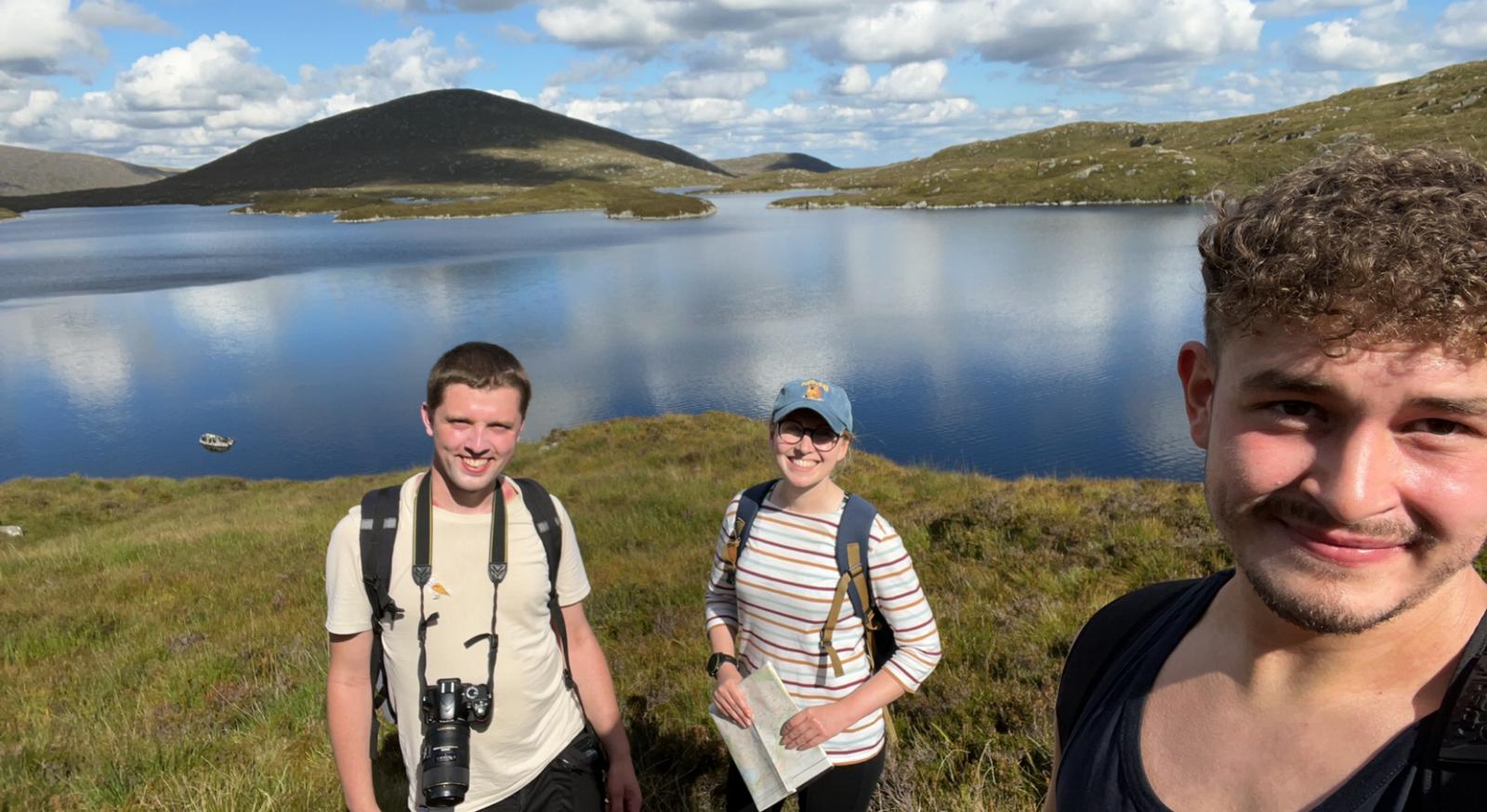
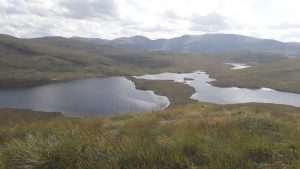 Our Project Support Officers have been spending time over late summer exploring key sites within the GSA Biosphere, including the Core Areas which are essential to our UNESCO designation: places with high conservation value, including threatened wildlife and habitats. Within these landscapes is a ‘sense of place’ which is experienced and interpreted differently by each visitor, and this intangible natural heritage is equally important to the Core Areas and our UNESCO Biosphere designation. Having already explored Cairnsmore of Fleet we asked Malcolm and Jake to visit then share their thoughts on Merrick Kells, a Special Area of Conservation (SAC) and Site of Special Scientific Interest.
Our Project Support Officers have been spending time over late summer exploring key sites within the GSA Biosphere, including the Core Areas which are essential to our UNESCO designation: places with high conservation value, including threatened wildlife and habitats. Within these landscapes is a ‘sense of place’ which is experienced and interpreted differently by each visitor, and this intangible natural heritage is equally important to the Core Areas and our UNESCO Biosphere designation. Having already explored Cairnsmore of Fleet we asked Malcolm and Jake to visit then share their thoughts on Merrick Kells, a Special Area of Conservation (SAC) and Site of Special Scientific Interest.
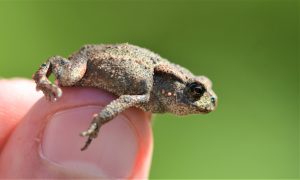
Merrick Kells was selected for SAC status for habitats that include ‘the most extensive representation of wet heath in the UK on an upland site south of the Scottish Highlands’; ‘the best developed areas of Siliceous alpine and boreal grasslands in the Southern Uplands of Scotland’, and ‘the most southerly of the characteristic oceanic Blanket bogs in the west of Scotland’ (source). Sites such as Merrick Kells can be challenging to access and explore (and planning is essential) but it is often wildness and ‘distance’ from everyday life and locations that make their sense of place so immersive and unforgettable. Pictured left is one of the Merrick locals, bufo bufo aka the common toad.
Malcolm:
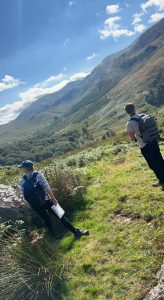 Robins foraging amongst the thicket, warbling their melodious tune, accompanied by a harmony of trickling water from the woodland stream and the quivering leaves blown by a westward wind. A calming symphony that belied the trial of perseverance we were set to begin.
Robins foraging amongst the thicket, warbling their melodious tune, accompanied by a harmony of trickling water from the woodland stream and the quivering leaves blown by a westward wind. A calming symphony that belied the trial of perseverance we were set to begin.
We ambled up the winding trail to a hill neighbouring Bruce’s Stone and were gifted a resplendent view of Loch Trool, its glimmering water broken only by a forlorn island of Scots pine. The Gairland Burn guided us onward; embellished with granite the stream shone like a jewel amongst the heather and upland grasses. We revitalized ourselves with a hearty lunch while a single golden ringed dragonfly prowled the water.
Heading on we reached Valley Loch, an expanse of water enveloped by harsh upland habitat. Here the silence was striking – neither bird nor beast could be heard or seen upon this weathered heath. An expanse of upland grasses dominates the landscape for miles, save these lochan oases. Loch Neldricken was our next refuge from this desolation, where black darters were driven into a mating frenzy, caught in a race of time to reproduce before the onset of winter conditions that will soon change their home.
A sinister presence loomed near: the infamous Murder Hole. Marred in a web of myth, this stagnant fringe of Loch Neldricken is said to be the final resting place for weary travellers cut low by bandits, cutthroats and thieves. We were relived to live in more lawful times!
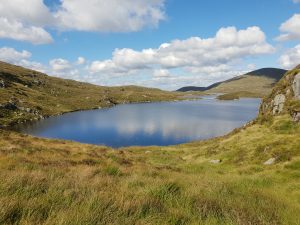 We slogged towards Ewe Rig; the terrain stubbornly unyielding with steep gradients, boggy mires and vast expanses of tussocks, coupled with the scorching rays off the sun draining our vitality. My muscles began to burn, my joints ached, and my willpower began to fade. Exhaustion took me and I lay down until a startled red grouse awoke me from my trance and we moved on.
We slogged towards Ewe Rig; the terrain stubbornly unyielding with steep gradients, boggy mires and vast expanses of tussocks, coupled with the scorching rays off the sun draining our vitality. My muscles began to burn, my joints ached, and my willpower began to fade. Exhaustion took me and I lay down until a startled red grouse awoke me from my trance and we moved on.
Loch Enoch (pictured left) was our final stop, the evening sun reflecting like a beacon. The sight and experience was one might expect in a higher 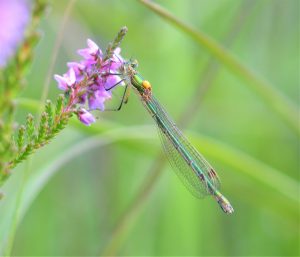 realm or the closing chapter of a fantasy novel and inspired new energy for our descent and journey home.
realm or the closing chapter of a fantasy novel and inspired new energy for our descent and journey home.
Standing guard over the valley is the Grey Man of Merrick. Stalwart and discerning he seemed to ponder our reasons for passing by. We instinctively talked to this rock in the likeness of a man, half expecting an answer. We bid him farewell as we lumbered homeward, all but spent and ready for sleep.
Pictured right is the damselfly lestes sponsa, one of the beautiful invertebrates we were able to photograph on the day.
Jake:
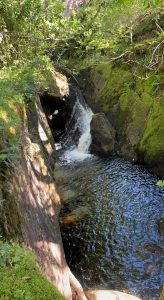 My first trip to Merrick Kells was a great success. The 17km journey over rough terrain was exhilarating. The trip began with a gentle gradual walk following a well-marked path with stunning views from the get-go that only improved as time went on. The landscape was littered with burns creating waterfalls and valleys which offered unique sights and beautiful areas for snack breaks.
My first trip to Merrick Kells was a great success. The 17km journey over rough terrain was exhilarating. The trip began with a gentle gradual walk following a well-marked path with stunning views from the get-go that only improved as time went on. The landscape was littered with burns creating waterfalls and valleys which offered unique sights and beautiful areas for snack breaks.
The path may have been well laid out and easy to follow but it was boggy in places leading to slow progress and almost forcing us to parkour our way across in places. This wasn’t always entirely successful and there were some legs temporarily lost to bogs and sink holes.
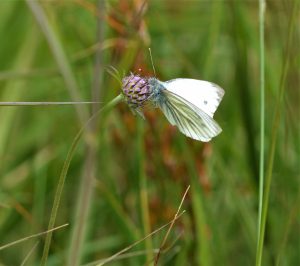 There was plenty of wildlife on display this trip with butterflies, birds and a whole gang of dragonflies hanging out by a sandy area on the edge of Loch Neldricken (Malcolm’s photo of pieris napi, the green-veined white butterfly, is here to the right). Thankfully there weren’t many of my old enemy the clegs, although the few that were there did seem to track me down. My favourite plant also made many appearances, the round leaved sundew plant is always a warmly welcomed sight for me since being introduced on our last outing to another of our Core Areas at Cairnsmore of Fleet.
There was plenty of wildlife on display this trip with butterflies, birds and a whole gang of dragonflies hanging out by a sandy area on the edge of Loch Neldricken (Malcolm’s photo of pieris napi, the green-veined white butterfly, is here to the right). Thankfully there weren’t many of my old enemy the clegs, although the few that were there did seem to track me down. My favourite plant also made many appearances, the round leaved sundew plant is always a warmly welcomed sight for me since being introduced on our last outing to another of our Core Areas at Cairnsmore of Fleet.
The lochs we passed were stunning with all sorts of interesting shapes and features. Lochs sported sand beaches and burns that fed other lochs offering surreal scenery that often forced us to stop just to admire it. As we ascended higher and higher all sorts of fantastic geological features were revealed.
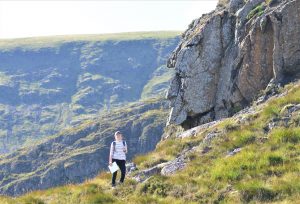 As we began to approach the end of our trek we were all exhausted and believed we would see no more wonders, but we were greeted by a final sight of beauty. The Grey Man of Merrick, a natural rock formation that looks strikingly like the face of an old man in the cliff face. Here he is on the left, ignoring Mary! I am already planning my next trip to this amazing area to visit the old man again and see what else the area has to offer and I can’t wait.
As we began to approach the end of our trek we were all exhausted and believed we would see no more wonders, but we were greeted by a final sight of beauty. The Grey Man of Merrick, a natural rock formation that looks strikingly like the face of an old man in the cliff face. Here he is on the left, ignoring Mary! I am already planning my next trip to this amazing area to visit the old man again and see what else the area has to offer and I can’t wait.
